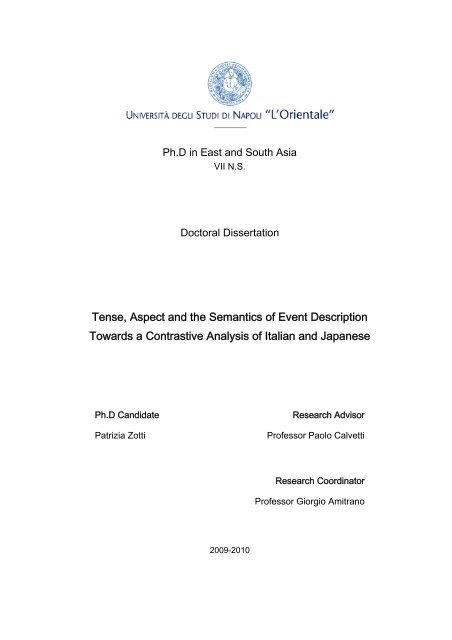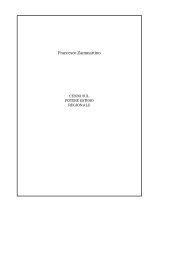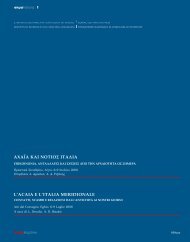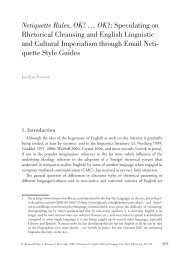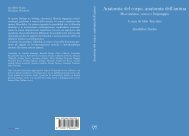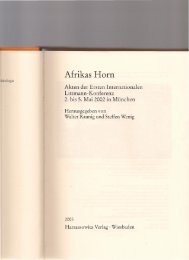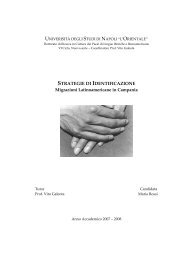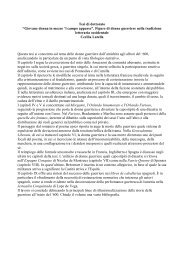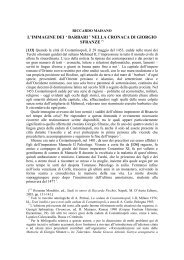Tense, Aspect and the Semantics of Event Description Towards a ...
Tense, Aspect and the Semantics of Event Description Towards a ...
Tense, Aspect and the Semantics of Event Description Towards a ...
Create successful ePaper yourself
Turn your PDF publications into a flip-book with our unique Google optimized e-Paper software.
Ph.D in East <strong>and</strong> South AsiaVII N.S.Doctoral Dissertation<strong>Tense</strong>, <strong>Aspect</strong> <strong>and</strong> <strong>the</strong> <strong>Semantics</strong> <strong>of</strong> <strong>Event</strong> <strong>Description</strong><strong>Towards</strong> a Contrastive Analysis <strong>of</strong> Italian <strong>and</strong> JapanesePh.D C<strong>and</strong>idatePatrizia ZottiResearch AdvisorPr<strong>of</strong>essor Paolo CalvettiResearch CoordinatorPr<strong>of</strong>essor Giorgio Amitrano2009-2010
To my familyTo my son2011
<strong>Tense</strong>, <strong>Aspect</strong> <strong>and</strong> <strong>the</strong> <strong>Semantics</strong> <strong>of</strong> <strong>Event</strong> <strong>Description</strong>s<strong>Towards</strong> a Contrastive Analysis <strong>of</strong> Italian <strong>and</strong> JapanesePatrizia ZottiAbstractTemporal analysis <strong>of</strong> events is an important part <strong>of</strong> many natural language processingtasks. We expect events to contain <strong>the</strong> same temporal information regardless<strong>of</strong> <strong>the</strong> language, however, <strong>the</strong> way temporal information is encoded via lexicalor grammatical properties differs from language to language.While <strong>the</strong> lexical aspect <strong>of</strong> event semantics is relatively similar across languages,<strong>the</strong> grammatical aspect varies greatly, <strong>and</strong> concepts <strong>of</strong> tense <strong>and</strong> aspect may notbe shared across languages, preventing a simple correspondence <strong>of</strong> verbal formsbetween two languages from being established, causing trouble for both human<strong>and</strong> machine translators alike.Divergence in temporal representations is illustrated by <strong>the</strong> following examples:(1) 田 中 さんは 学 校 に 電 車 で 通 っている。Tanaka san wa gakkō ni densha de kayotte iruIl sig. Tanaka va a scuola in treno.‘Mr Tanaka commutes to school by train.’(2) 田 中 さんは 只 今 学 校 に 電 車 で 通 っている。Tanaka san wa tadaima gakkō ni densha de kayotte iruIl sig. Tanaka ora sta <strong>and</strong><strong>and</strong>o a scuola in treno.‘Mr Tanaka is now commuting to school by train.’The Italian <strong>and</strong> English translations use different verbal forms <strong>and</strong> aspectual configurations,<strong>the</strong> imperfective (habitual) aspect in (1) <strong>and</strong> <strong>the</strong> progressive aspect in(2), whereas both Japanese sentences contain <strong>the</strong> same verbal form -te iru <strong>and</strong>make use <strong>of</strong> <strong>the</strong> adverb ima ‘now’ to indicate <strong>the</strong> progressive aspect. In translating<strong>the</strong>se sentences, we need to be aware <strong>of</strong> <strong>the</strong>se differences in temporal informationrepresentations.This work represents a first <strong>the</strong>oretical <strong>and</strong> empirical contrastive investigation onhow temporal information is conveyed in Japanese <strong>and</strong> Italian with a focus on <strong>the</strong>semantics <strong>of</strong> events <strong>and</strong> how <strong>the</strong>y are reported. We include a classification <strong>of</strong>eventuality types <strong>and</strong> <strong>the</strong>ir expression in tense <strong>and</strong> aspect, making this work usefulfor researchers working on tasks that require detailed, cross-lingual temporalanalysis.We empirically support our <strong>the</strong>oretical proposal by semi-automatically annotating aparallel Japanese-Italian corpus <strong>of</strong> novels, parliamentary proceedings <strong>and</strong> newspaperstranslations with temporality tags <strong>and</strong> conducting an investigation into <strong>the</strong>representation <strong>of</strong> temporal phenomena across languages.Keywords:tense, aspect, temporality tags, Japanese, Italian, Japanese Italian parallel corpus
AcknowledgementsI would like to thank everyone helped me during this work. It is almost impossibleto mention all <strong>of</strong> <strong>the</strong>m <strong>and</strong> to express all my gratitude.My first <strong>and</strong> biggest thanks goes to my advisor, Pr<strong>of</strong>essor Paolo Calvetti for hisguidance <strong>and</strong> support, for criticism <strong>and</strong> discussion, for <strong>the</strong> patience in carefullyreading <strong>and</strong> commenting my drafts, <strong>and</strong> for his constant encouragement.I would also like to thank Pr<strong>of</strong>essor Matsumoto Yuji – Director <strong>of</strong> <strong>the</strong> ComputationalLinguistics Laboratory at NAIST, Japan – <strong>and</strong> assistant Pr<strong>of</strong>essor Asahara Masayuki.I’m very grateful to Pr<strong>of</strong>essor Matsumoto for welcoming me in <strong>the</strong> lab when Iwas unfamiliar with computational linguistics, <strong>and</strong> for allowing me to spend twoyears <strong>the</strong>re. I’m very thankful to pr<strong>of</strong>essor Asahara Masayuki too, for opening myeyes to totally new perspectives, <strong>and</strong> for his guidance <strong>and</strong> support in designing<strong>and</strong> developing <strong>the</strong> tagging procedure <strong>and</strong> <strong>the</strong> computational task.I’m very grateful to Pr<strong>of</strong>essor Silvio Vita – Director <strong>of</strong> ISEAS (Italian School <strong>of</strong> EastAsian Studies) for motivating, helping <strong>and</strong> supporting me in more than two years inJapan. I want to thank Yamamoto Makimi (ISEAS) too, for her kindness <strong>and</strong> help ineveryday life.My deepest gratitude goes to Shoyu Club for supporting this research in Japan fortwo years. I’m very thankful to its Executive Director, Daigo Tadahisa, for patientlyreading all my periodic reports <strong>and</strong> for his questions <strong>and</strong> comments.Many thanks goes to Dr. Gianluca Coci from University <strong>of</strong> Turin, Dr. Laura Testaverde<strong>and</strong> Dr. Aless<strong>and</strong>ro Clementi, for helping in <strong>the</strong> corpus development providing<strong>the</strong> pre-print versions <strong>of</strong> <strong>the</strong>ir Japanese novels’ translations into Italian.I would like to thank Pr<strong>of</strong>essor Franco Mazzei, Pr<strong>of</strong>essor Giorgio Amitrano <strong>and</strong>Pr<strong>of</strong>essor Silvana De Maio from Università degli Studi di Napoli ‘L’Orientale’ for<strong>the</strong>ir help <strong>and</strong> support.A big thanks goes to Pr<strong>of</strong>essor Maddalena Toscano from Università degli Studi diNapoli ‘L’Orientale’, for her precious advice, <strong>and</strong> for encouraging me to apply forthis Ph.D.I also want to thank all my colleagues <strong>and</strong> friends at Matsumoto Lab for day-to-daydiscussion, for sharing <strong>the</strong>ir thoughts <strong>and</strong> for hanging out with me. Thank to EricNichols for his useful comments on my abstracts <strong>and</strong> papers, <strong>and</strong> for helping me tosort out various tasks; to Hiromi Ōyama for her help with <strong>the</strong> Japanese languageiii
<strong>and</strong> for her friendship; to Jordi Polo <strong>and</strong> Francisco Dalla Rosa for <strong>the</strong>ir advices <strong>and</strong>support; to Manabu Kimura, Jessica C. Ramirez, Hiram Calvo, Erlyn Manguilimotan,Watanabe Yotaro, <strong>and</strong> many more.I owe a big thanks to Robert Wener <strong>and</strong> to Pr<strong>of</strong>. Natalia L. Tornesello editing this<strong>the</strong>sis <strong>and</strong> making it presentable to <strong>the</strong> international community.Finally, my deepest thanks is to my supportive husb<strong>and</strong> for always believing in me,for helping in many tasks, <strong>and</strong> for taking care <strong>of</strong> our little son.iv
List <strong>of</strong> AbbreviationsOBJGENLOCNEGNOMNON PASTPASTQTOPaccusativegenitivelocativenegativenominativenon-past tensepast tensequestion particletopicv
General RemarksJapanese names <strong>and</strong> sentences are Romanized following <strong>the</strong> Hepburn system,according to which vowels are pronounced as in Italian, consonants as in English,<strong>and</strong> long vowels are marked with a macron.According to <strong>the</strong> Japanese use <strong>the</strong> family name always precedes <strong>the</strong> name, as inKindaichi Haruhiko.Examples taken from o<strong>the</strong>r authors have been transcript according to <strong>the</strong> Hepburnsystem if originally in a different form.The interlinear annotation <strong>of</strong> <strong>the</strong> parts <strong>of</strong> speech has been adopted only if necessary.vi
List <strong>of</strong> FiguresFigure 1 – Temporal System <strong>of</strong> Natural Languages .....................................................4Figure 2 – Classification <strong>of</strong> <strong>Aspect</strong>ual Oppositions (Comrie 1976).............................23Figure 3 – Diagram <strong>of</strong> <strong>the</strong> <strong>Tense</strong>s <strong>of</strong> <strong>the</strong> Indicative in Italian ......................................93Figure 4 – The structure <strong>of</strong> Italian Actionality ............................................................101Figure 5 – The Structure <strong>of</strong> Italian <strong>Aspect</strong>uality.........................................................103Figure 6 – Automatic Estimation <strong>of</strong> <strong>Tense</strong>, <strong>Aspect</strong> <strong>and</strong> <strong>Event</strong> Class ........................ 111Figure 7 – Corpus Based Approach.......................................................................... 112Figure 8 – Corpus Driven Approach.......................................................................... 112Figure 9 – POS Tagging <strong>of</strong> Italian <strong>and</strong> Japanese Sentences ................................... 116Figure 10 – The Italian Tag Set ................................................................................. 117Figure 11 – Excerpt from <strong>the</strong> PEI Corpus .................................................................120Figure 12 – Kudo’s Verb Classification .....................................................................124Figure 13 – Verb Class Distribution – Japanese Data ..............................................127Figure 14 – Verb Class Distribution – Italian Data ....................................................127Figure 15 – Excerpt from <strong>the</strong> Tagged Corpus (Japanese Section)...........................128Figure 16 – Excerpt from <strong>the</strong> Tagged Corpus (Italian Section).................................128Figure 17 – TAGPEI Jp – The Tool for Temporal Annotation ....................................131Figure 18 – Parsed Output........................................................................................132Figure 19 – The Annotated Parallel Corpus..............................................................133Figure 20 – The Automatic Estimation Pipeline ........................................................135Figure 21 – <strong>Tense</strong>, <strong>Aspect</strong> <strong>and</strong> <strong>Event</strong> Estimation (Italian Data)................................139Figure 22 – <strong>Tense</strong>, <strong>Aspect</strong> <strong>and</strong> <strong>Event</strong> Estimation (Japanese Data) .........................140Figure 23 – <strong>Tense</strong>, <strong>Aspect</strong> <strong>and</strong> <strong>Event</strong> Estimation 2 (Italian Data).............................141vii
List <strong>of</strong> TablesTable 1 – Hornstein’s Basic <strong>Tense</strong> Representation .................................................... 14Table 2 – Reichenbach’s Diagrams for Complex <strong>Tense</strong>s ........................................... 14Table 3 – Soga’s Diagrams for <strong>the</strong> Japanese <strong>Tense</strong> System ..................................... 15Table 4 – Bertinetto’s Diagrams for <strong>the</strong> Italian <strong>Tense</strong> System (Bertinetto 1986a) ...... 17Table 5 – Interaction between Lexical <strong>and</strong> Grammatical <strong>Aspect</strong>................................ 27Table 6 – Vendler Classification .................................................................................. 29Table 7 – Rothstein Classification ............................................................................... 31Table 8 – Van Lambalgen <strong>and</strong> Hamm Classification .................................................. 32Table 9 – Possible Interpretations <strong>of</strong> <strong>Tense</strong> Forms..................................................... 50Table 10 – Possible Time Relationships in Complex Sentences................................ 54Table 11 – Kindaichi Classification .............................................................................. 56Table 12 – Kindaichi <strong>and</strong> Fujii Classification (merged) ............................................... 61Table 13 – Nakamura’s Features................................................................................ 65Table 14 – Nakamura’s Verb Classification <strong>and</strong> Related <strong>Aspect</strong>................................ 66Table 15 – Matsumoto <strong>and</strong> Oishi’s Feature-Based Framework ................................. 73Table 16 – Class <strong>of</strong> Adverbs in <strong>the</strong> Japanese Language............................................ 75Table 17 – Effects <strong>of</strong> <strong>the</strong> Temporal Adverbs on <strong>the</strong> <strong>Aspect</strong>ual Values........................ 76Table 18 – <strong>Aspect</strong>ual Morphemes <strong>and</strong> <strong>the</strong>ir Semantic Value ..................................... 91Table 19 – <strong>Aspect</strong> Values <strong>and</strong> <strong>Semantics</strong> in Italian ..................................................107Table 20 – The PEI Corpus....................................................................................... 119Table 21 – <strong>Event</strong> Class – English, Italian <strong>and</strong> Japanese Verbs................................125Table 22 – <strong>Tense</strong>, <strong>Aspect</strong> <strong>and</strong> <strong>Event</strong> Class Attributes...............................................134Table 23 – ISST ConLL Extract.................................................................................137Table 24 – POS Tagging with <strong>the</strong> two Italian POS Tag Sets.....................................137Table 25 – V-te iru Distribution in <strong>the</strong> PEI Corpus.....................................................146Table 26 – The Process to Determine <strong>the</strong> Meaning <strong>of</strong> <strong>the</strong> Form V-te iru .................160Table 27 – The Process to Determine <strong>the</strong> Meaning <strong>of</strong> <strong>the</strong> <strong>Aspect</strong>ual Periphrasis ... 173viii
ContentsCONTENTS..........................................................................................................IX1 INTRODUCTION........................................................................................... 11 Motivation.......................................................................................... 12 Methodological Note ......................................................................... 23 Literature........................................................................................... 24 Thesis Organization .......................................................................... 32 THEORETICAL BACKGROUND.................................................................. 42.1 Overview ........................................................................................... 42.2 Language <strong>and</strong> Cognition in <strong>the</strong> Temporal Domain ............................ 62.3 Conceptualising Time........................................................................ 62.3.1 Time as Duration............................................................................... 72.3.2 Temporal Perspective: Past, Present <strong>and</strong> Future .............................. 82.3.3 Time as a Succession ....................................................................... 92.4 Time <strong>and</strong> Language ........................................................................ 102.4.1 <strong>Event</strong>s <strong>and</strong> States ........................................................................... 102.4.2 Theories <strong>of</strong> <strong>Tense</strong> <strong>and</strong> <strong>Aspect</strong> ......................................................... 112.4.2.1 <strong>Tense</strong> ..........................................................................................122.4.2.2 <strong>Aspect</strong>.........................................................................................172.4.2.3 Cross Linguistic Differences .......................................................182.5 Concluding Remarks....................................................................... 193. A THEORY OF ASPECT............................................................................. 203.1 Overview ......................................................................................... 203.2 Lexical <strong>Aspect</strong> ................................................................................. 203.3 Grammatical <strong>Aspect</strong> ........................................................................ 233.4 Interaction between Lexical <strong>and</strong> Grammatical <strong>Aspect</strong>..................... 253.5 <strong>Event</strong> Classification......................................................................... 283.5.1 Vendler (1957) ................................................................................ 283.5.2 Dowty (1979)................................................................................... 303.5.3 Rothstein (2004).............................................................................. 30ix
3.5.4 Van Lambalgen <strong>and</strong> Hamm (2005)................................................. 313.6 <strong>Aspect</strong> as a Choice (Smith 1991) ................................................... 333.7 Compositional <strong>Aspect</strong> ..................................................................... 343.8 Concluding Remarks....................................................................... 364. TENSE, ASPECT AND EVENTS: THE JAPANESE CASE........................ 384.1 Overview......................................................................................... 384.2 <strong>Tense</strong> .............................................................................................. 404.2.1 Relative <strong>Tense</strong> Theory .................................................................... 414.2.1.1 <strong>Tense</strong> Forms............................................................................... 434.2.1.2 Order <strong>of</strong> <strong>Event</strong>s .......................................................................... 514.3 <strong>Event</strong> Classification......................................................................... 544.3.1 Kindaichi Haruhiko.......................................................................... 554.3.1.1 Problems Arising from Kindaichi’s Classification ........................ 594.3.1.2 Kindaichi (1950) <strong>and</strong> Vendler (1957): a Comparison.................. 624.3.2 Okuda (1978a; 1978b) <strong>and</strong> Jacobsen (1992) ................................. 634.3.3 Nakamura (2001) ............................................................................ 654.3.4 Kudo M. (1995) ............................................................................... 694.3.5 Matsumoto <strong>and</strong> Oishi (1997)........................................................... 734.3.6 Temporal Adverbs ........................................................................... 744.4 <strong>Aspect</strong> Morphemes ......................................................................... 774.4.1 V-te iru ............................................................................................ 774.4.2 V-te aru ........................................................................................... 804.4.3 V-te shimau..................................................................................... 814.4.4 V-te iku <strong>and</strong> V-te kuru...................................................................... 824.4.5 VB2-owaru <strong>and</strong> VB2-oeru ............................................................... 874.4.6 VB2-tsuzukeru/tsuzuku ................................................................... 884.4.7 VB2-hajimeru/dasu ......................................................................... 884.4.8 VB2-kakeru ..................................................................................... 894.5 Concluding Remarks....................................................................... 905. TENSE, ASPECT AND EVENTS: THE ITALIAN CASE............................. 925.1 Overview......................................................................................... 92x
5.2 <strong>Tense</strong> .............................................................................................. 925.2.1 Simple Present, Simple Future <strong>and</strong> Compound Future................... 935.2.2 Simple Past, Compound Past <strong>and</strong> Imperfect................................... 955.2.2.1 The ‘Narrative Imperfect’ ............................................................985.3 Situation <strong>and</strong> Viewpoint <strong>Aspect</strong> ..................................................... 1005.3.1 Situation <strong>Aspect</strong> ............................................................................ 1005.3.2 Viewpoint <strong>Aspect</strong>. Perfectivity vs. Imperfectivity............................ 1025.3.3 Lexical Morphemes <strong>and</strong> <strong>Aspect</strong>ual Periphrasis............................. 1045.4 Temporal Adverbs in Italian ........................................................... 1085.5 Concluding Remarks..................................................................... 1096. AUTOMATIC ESTIMATION OF TENSE, ASPECT AND EVENTS ........... 1116.1 Overview ........................................................................................1116.2 Corpus Driven Approach <strong>and</strong> Definitional Issues ...........................1116.2.1 Corpus Annotation as a Methodology ........................................... 1156.3 The PEI Corpus............................................................................. 1186.4 An Annotation Scheme for Temporal Relations ............................. 1206.4.1 The Temporal Labels..................................................................... 1216.5 Corpus Annotation......................................................................... 1296.5.1 Methodology.................................................................................. 1296.5.2 TAGPEI – <strong>the</strong> Annotation Tool....................................................... 1296.6 <strong>Tense</strong>/<strong>Aspect</strong>/<strong>Event</strong> Class Estimation – The Experimental Setup....... 1346.6.1 Results <strong>and</strong> Discussion................................................................. 1386.7 Concluding Remarks..................................................................... 1427 ITALIAN AND JAPANESE: A COMPARISON .......................................... 1437.1 Overview ....................................................................................... 1437.2 V-te iru........................................................................................... 1447.2.1 Permanence <strong>of</strong> Results <strong>and</strong> Pure State ........................................ 1467.2.2 Pure State Meaning....................................................................... 1517.2.3 Progressive Meaning .................................................................... 1527.2.4 Habitual <strong>and</strong> Iterative-Durative Meaning ....................................... 1577.2.5 Experiential Meaning..................................................................... 158xi
7.2.6 Discussion .................................................................................... 1597.3 The Italian Periphrasis <strong>and</strong> <strong>the</strong>ir Japanese Counterparts ............. 1617.3.1 The Progressive Periphrasis......................................................... 1617.3.2 The Imminential Periphrasis ......................................................... 1637.3.3 Phasal Periphrasis: inchoative, continuative, <strong>and</strong> conclusive ....... 1657.3.3.1 The inchoative periphrasis (VB2-dasu/hajimeru, V-te iku/kuru) 1657.3.3.2 The continuative periphrasis..................................................... 1677.3.3.3 The Terminative or Conclusive Periphrasis .............................. 1707.3.3.4 Discussion ................................................................................ 1717.4 Concluding Remarks..................................................................... 1748. CONCLUSIONS AND FUTURE WORK ................................................... 1768.1 Conclusions .................................................................................. 1768.2 Future Work .................................................................................. 177REFERENCES.................................................................................................. 179APPENDICES................................................................................................... 193A – TAGPEI....................................................................................................... 194B – TAGGED EXAMPLES................................................................................ 210C – THE PEI CORPUS ..................................................................................... 213xii
[…] Me l'astipoe dimane m' 'o bevo?’Dimane nun esiste.E 'o juorno primma,siccome se n 'è gghiuto,manco esiste.Esiste sulamentestu mumento'e chistu rito 'e vino int' 'a butteglia. […]E allora bevo...E chistu surz' 'e vinovence 'a partita cu l'eternità!Eduardo De Filippo
Chapter 11 Introduction1 MotivationThis <strong>the</strong>sis stems from two basic observations: 1. ‘events’, considered as ‘happenings’in <strong>the</strong> real world, contain <strong>the</strong> same temporal information regardless <strong>of</strong> <strong>the</strong>language in which <strong>the</strong>y are conveyed, but <strong>the</strong> way in which such information isencoded via lexical or grammatical properties differs from language to language.While <strong>the</strong> lexical aspect <strong>of</strong> event semantics is relatively similar across languages,<strong>the</strong> grammatical aspect varies greatly. Concepts <strong>of</strong> tense <strong>and</strong> aspect may not beshared across languages, thus preventing a simple correspondence <strong>of</strong> verbalforms between languages from being established; 2. Temporal analysis <strong>of</strong> ‘events’is an important part <strong>of</strong> many natural language processing tasks such as textsummarization (temporally ordering information), information extraction (e.g.,normalizing information for database entry) question-answering (e.g., answering‘when' questions by temporally anchoring events) <strong>and</strong> machine-translation. Studies<strong>and</strong> experiments in <strong>the</strong> field <strong>of</strong> temporal annotation may contribute to <strong>the</strong> development<strong>of</strong> increasingly sophisticated applications.The aim <strong>of</strong> <strong>the</strong> present work is two-fold:1. To conduct a <strong>the</strong>oretical <strong>and</strong> empirical contrastive investigation on howtemporal information is conveyed in Japanese <strong>and</strong> Italian with a focus on<strong>the</strong> semantics <strong>of</strong> events <strong>and</strong> how <strong>the</strong>y are reported, which includes <strong>the</strong>notion <strong>of</strong> eventuality types <strong>and</strong> <strong>the</strong>ir expression in tense <strong>and</strong> aspect, empiricallysupported by semi-automatically annotating a parallel Japanese-Italiancorpus with temporality tags;2. To define an automatic procedure for temporal tagging to be used innatural language processing applications <strong>and</strong> by researchers working ontasks requiring detailed, cross-lingual temporal analysis.The intended users <strong>of</strong> <strong>the</strong> annotated data are <strong>the</strong> overall linguistic community, <strong>the</strong>community involved in processing Natural Languages, system developers involvedin building tagging programs to extract temporal information <strong>and</strong> those who are de-1
veloping Machine Translation Systems <strong>and</strong> Second Language teachers interestedin data which may be easily compared in <strong>the</strong> two languages under discussion.2 Methodological NoteWe have conducted <strong>the</strong> analysis by designing, creating <strong>and</strong> semi-automaticallyannotating a parallel Japanese-Italian corpus <strong>of</strong> novels, parliamentary proceedings<strong>and</strong> newspapers translations with temporality tags, <strong>and</strong> conducting an investigationinto <strong>the</strong> representation <strong>of</strong> temporal phenomena across <strong>the</strong> two languages.We have adopted <strong>the</strong> corpus-driven approach for <strong>the</strong> benefits normally associatedwith it: a better underst<strong>and</strong>ing <strong>of</strong> <strong>the</strong> phenomena <strong>of</strong> concern <strong>and</strong> resources for <strong>the</strong>training <strong>and</strong> evaluation <strong>of</strong> algorithms to automatically identify features <strong>and</strong> relations<strong>of</strong> interest. Both <strong>the</strong> Japanese <strong>and</strong> <strong>the</strong> Italian sections <strong>of</strong> <strong>the</strong> parallel corpushave been first pre-processed through stable morphological analysers <strong>and</strong> <strong>the</strong>ntagged with a tool we have specifically built for <strong>the</strong> purposes <strong>of</strong> this research.Given <strong>the</strong> lack <strong>of</strong> parallel resources in Japanese <strong>and</strong> Italian, <strong>the</strong> parallel (translationcorpus) in itself may be considered one <strong>of</strong> <strong>the</strong> results <strong>of</strong> this work. The datacollected may represent a relevant base <strong>of</strong> data for comparable linguistic analysisnot only on event semantics, but also on o<strong>the</strong>r linguistic domains.3 LiteratureThis <strong>the</strong>sis lies at <strong>the</strong> intersection <strong>of</strong> linguistics, logic, cognitive <strong>and</strong> computationalscience. To meet <strong>the</strong> increasing dem<strong>and</strong> on <strong>the</strong> processing <strong>of</strong> temporal informationa deep interaction between artificial intelligence, logic <strong>and</strong> formal linguistic <strong>the</strong>oriesis needed, namely an interaction between three domains: i) <strong>the</strong>ories <strong>of</strong> tense <strong>and</strong>aspect <strong>and</strong> event structure; ii) reasoning about time <strong>and</strong> events; iii) annotationschemes <strong>and</strong> tools.We have reviewed previous works both in <strong>the</strong> field <strong>of</strong> <strong>the</strong>oretical <strong>and</strong> computationallinguistics. A full mastery <strong>of</strong> <strong>the</strong> relevant literature <strong>of</strong> all <strong>the</strong>se areas is howeverfar beyond <strong>the</strong> scope <strong>of</strong> <strong>the</strong> present work, focussing on <strong>the</strong> devices employedby Italian <strong>and</strong> Japanese speakers to express temporality.To this extent, we have taken into account previous studies on <strong>the</strong> semantics <strong>of</strong>events <strong>and</strong> <strong>the</strong>ir expression in tense <strong>and</strong> aspect, as well as those on temporalannotation. We have tried to make use <strong>of</strong> <strong>the</strong> extensive literature on <strong>the</strong>se twosubjects in order to pinpoint <strong>the</strong> linguistic devices used in <strong>the</strong> two languages toconvey events.2
4 Thesis OrganizationThis <strong>the</strong>sis is organized as follows.Chapter 2 is devoted to <strong>the</strong> <strong>the</strong>oretical background <strong>of</strong> which two elements arepresented: 1) <strong>the</strong> main <strong>the</strong>ories concerned with time; 2) <strong>the</strong> way natural languagesconvey it.Chapter 3 is concerned with <strong>the</strong> <strong>the</strong>ories on <strong>Tense</strong> <strong>and</strong> <strong>Aspect</strong>. The main <strong>the</strong>oreticalpositions about <strong>Tense</strong> <strong>and</strong> <strong>the</strong> difference between Viewpoint/Grammatical <strong>and</strong>Situation/Lexical <strong>Aspect</strong> are outlined. Traditional <strong>and</strong> innovative generalist approachesare reviewed.Chapter 4 <strong>and</strong> 5 are respectively devoted to <strong>the</strong> way in which Japanese <strong>and</strong> Italianconvey <strong>the</strong> temporal perspective with a focus on tense <strong>and</strong> aspect <strong>and</strong> on <strong>the</strong>irinteraction.Chapter 6 <strong>and</strong> 7 represent <strong>the</strong> core <strong>of</strong> <strong>the</strong> research. Chapter 6 presents <strong>the</strong> parallelcorpus, <strong>the</strong> temporal annotation methodology <strong>and</strong> <strong>the</strong> experimental setting for<strong>the</strong> automatic estimation <strong>of</strong> tense, aspect <strong>and</strong> event class. Chapter 7 is devoted to<strong>the</strong> contrastive analysis between Japanese <strong>and</strong> Italian as far as aspect <strong>and</strong> eventclasses are concerned, carried on by querying <strong>the</strong> tagged parallel corpus illustratedin chapter 6.Conclusions are drawn in chapter 8.3


